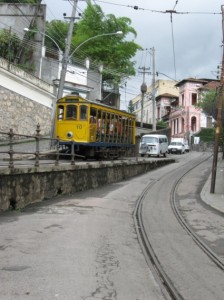
Photo © Michael Sommers.
One of Rio de Janeiro’s oldest and most charming neighborhoods is the bucolic hillside bairro of Santa Teresa , whose gracious villas and winding cobblestoned streets gaze out over the blue waters of the Baía de Guanabara.Oozing in atmosphere, in recent years Santa Teresa – or “Santa” as it is fondly referred to by locals – has undergone a revitalization that has transformed it into one of Rio’s most sought-after neighborhoods by both locals and foreigners, who are drawn to its bohemian artist vibe as well as its growing number of boutique hotels and funky bistros. And yet, despite its proximity to Rio’s Centro and Lapa, the largely residential neighborhood has managed to stave off hordes due to the narrowness of its steep streets and relatively difficult access. There are only two ways to reach Santa on public transportation: by taking a hard-to-find minibus or by hopping one of the picturesque old bondes (trolleys) that go clattering up the hill from the Estação Carioca, adjacent to Centro’s Carioca Metró station.
Riding one of the brightly painted yellow bondes is an attraction in itself. The views (especially when you go sailing atop the Arcos de Lapa aqueduct) are pretty stupendous and the journey aboard the open-air trolley possesses some of the careening thrill of a ride at an amusement park.
Tragically, there was nothing amusing about the catastrophic accident that occurred this weekend, on the afternoon of August 27. While taking one of Santa’s severe curves, a bonde went off the rails and crashed, killing five people and injuring another 57, some of them very seriously. Among the fatal victims was the conductor, whose birthday it happened to be.
So far, causes of the crash are being hotly disputed. The commander of the fire brigade that was sent to the scene noted that the bonde was over its passenger limit (a common occurrence considering how passengers can just hop on and off in mid-journey); at the time of the accident, there were 60 passengers aboard instead of the official limit of 44. Meanwhile, engineers from the Commission of Accident Analysis and Prevention of CREA, (Regional Council of Architecture and Engineering) initially suspected faulty brakes – a hypothesis hotly disputed by Rio’s state Secretary of Transport – before finding signs of poorly maintained and worn equipment (in place of a screw, a piece of wire was discovered holding together two parts near the brake).
Meanwhile, outraged residents of Santa Teresa who travel the bondes everyday claim that this was an accident waiting to happen. Noting that of the five trolleys currently in operation, three newer light rail vehicles have difficulty navigating the sharp curves while the two oldest ones are in a precarious state of conservation, lawyer Abaeté Mesquita, director of the Santa Teresa Residents’ Association (AMAST), declared: “This was a tragedy foretold.” Indeed, only the day before, the same bonde had smashed into a bus, although no damage or passenger injuries had occurred.
As a result of this catastrophe, all trolley service to Santa Teresa has been suspended indefinitely. The governor of Rio de Janeiro, Sérgio Cabral, apologized profoundly for the accident and vowed that, pending the results of an investigation into its causes, the state minister of transportation will take appropriate measures that will include the modernization of all the bondes.
The government’s embarrassment is compounded by the fact that this incident isn’t the only fatal bonde accident this year. In June, a 24-year-old French tourist who was standing on the edge of the running board, taking photographs, slipped and fell to his death while the trolley was passing over the Arcos da Lapa.